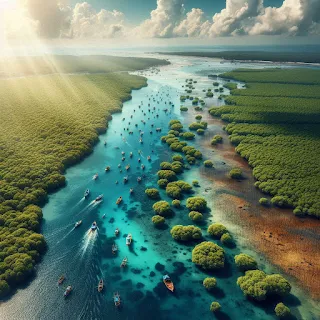India, one of the world's largest and fastest-growing economies, has committed to achieving net-zero carbon emissions by 2070. While the focus has largely been on renewable energy and electrification, an equally powerful yet overlooked ally exists along India’s vast coastline: coastal ecosystems. Mangroves, seagrasses, salt marshes, and tidal wetlands, collectively known as "blue carbon" ecosystems, can play a significant role in sequestering atmospheric carbon and enhancing climate resilience.
What Are Coastal Ecosystems?
Mangroves
Mangroves are salt-tolerant trees that grow in intertidal zones. India has over 4,900 square kilometers of mangrove cover.
Seagrasses
Seagrasses are flowering marine plants found in shallow waters. They support biodiversity and trap carbon efficiently.
Salt Marshes & Wetlands
These are flood-prone areas that store large amounts of organic carbon in their soils, often for centuries.
The Blue Carbon Advantage
High Carbon Sequestration Rates
Coastal ecosystems can sequester up to 10 times more carbon per unit area than terrestrial forests.
Long-Term Storage
Unlike forests where carbon is stored in biomass, blue carbon is stored in soils and sediments, making it less prone to release.
Protection Against Natural Disasters
Mangroves and wetlands reduce the impact of cyclones, floods, and tsunamis—a key co-benefit for climate adaptation.
India's Coastal Wealth: An Untapped Resource
Extensive Coastline
India has a 7,517 km coastline, offering immense potential for blue carbon projects.
Existing Biodiversity Hotspots
Sundarbans (West Bengal), Pichavaram (Tamil Nadu), and Bhitarkanika (Odisha) are prime examples of biodiversity-rich mangrove ecosystems.
Socioeconomic Benefits
Protecting coastal ecosystems creates sustainable jobs in ecotourism, fisheries, and carbon offset markets.
Challenges to Leveraging Blue Carbon
Policy Gaps
India’s carbon market and NDCs (Nationally Determined Contributions) currently do not explicitly include blue carbon.
Scientific Monitoring
Robust data collection on carbon sequestration rates is lacking.
Coastal Degradation
Urbanization, pollution, and unsustainable tourism continue to degrade coastal habitats.
Path Forward: Strategies for Integration
Include Blue Carbon in Climate Policies
India should recognize blue carbon in its climate strategies, including NDC updates and carbon pricing frameworks.
Community-Based Conservation
Involve coastal communities in conservation efforts through training, funding, and ownership of local ecosystems.
Public-Private Investment
Green bonds and CSR funding can support the protection and restoration of these ecosystems.
Regional Cooperation
India can collaborate with other South Asian countries to share best practices and resources.
Conclusion
As India works toward its ambitious 2070 net-zero target, integrating coastal ecosystems into its climate strategy can offer multiple benefits. Blue carbon not only helps in carbon sequestration but also improves biodiversity, disaster resilience, and sustainable livelihoods. Recognizing and investing in these natural assets is no longer optional—it’s essential.


No comments:
Post a Comment